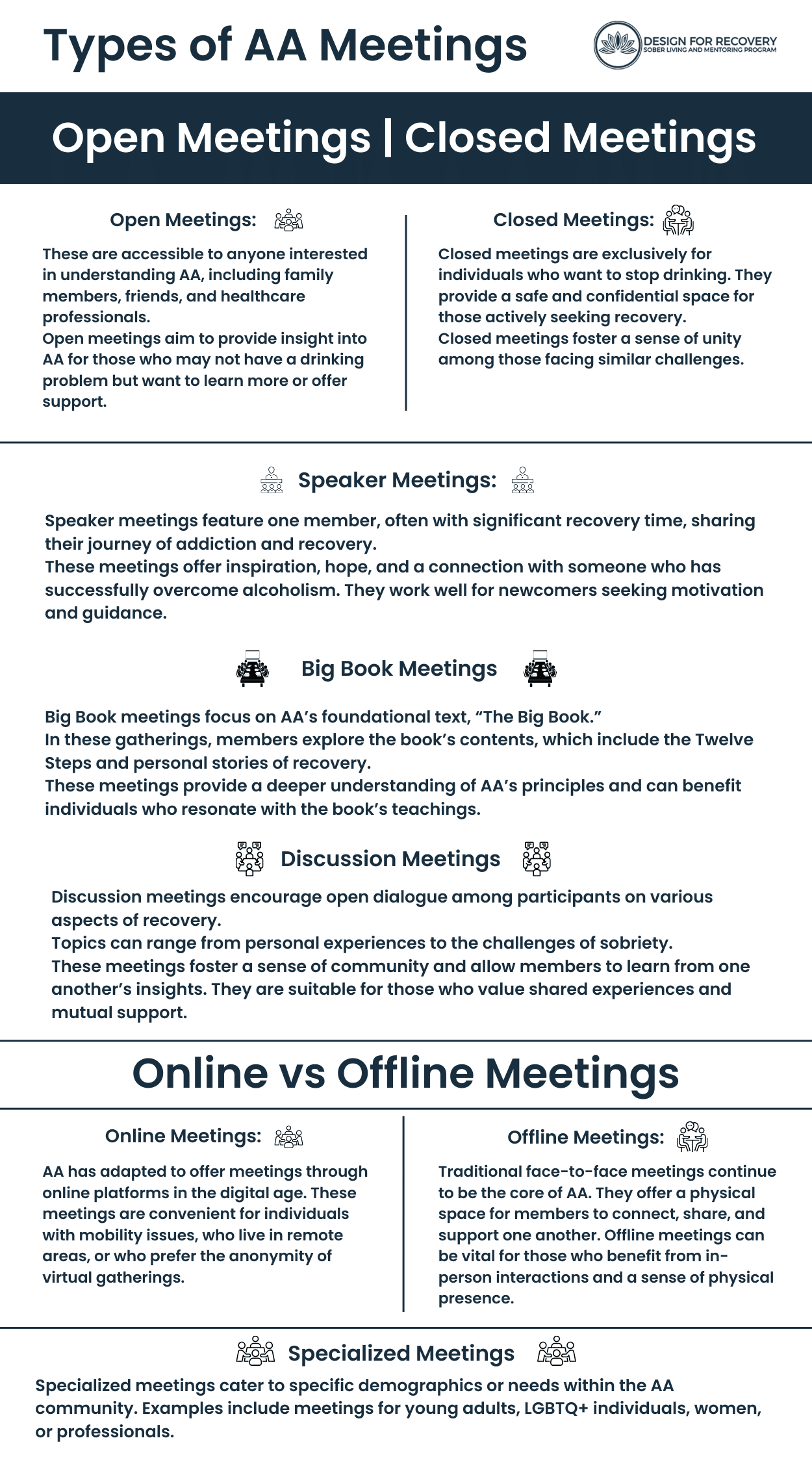What is Alcoholics Anonymous?
Alcoholics Anonymous (AA) is a globally recognized support group that assists individuals struggling with alcohol addiction.
It was founded in 1935 by Bill Wilson and Dr. Bob Smith. Its primary mission is to help those suffering from alcohol addiction achieve and maintain sobriety.
How Does Alcoholics Anonymous Work?
AA works through a mutual support model where individuals struggling with alcohol addiction share their experiences, challenges, and triumphs.
It’s a fellowship built on honesty, self-reflection, and mutual assistance.
Central to its operation are the 12 Step programs and 12 Traditions of AA, which provide a structured path to recovery.
Members attend AA meetings to discuss their struggles, receive support, and offer support to others, creating a nurturing and empathetic community dedicated to achieving and maintaining sobriety.
Who are A.A. Members?
AA members, often referred to simply as “members,” are individuals from various walks of life who have acknowledged their alcohol use disorder and are committed to quitting drinking.
How is AA Organized and Financed?
AA is organized and financed through a decentralized structure with local AA groups and a general service office.
It operates primarily on contributions from its members and does not accept external funding to maintain autonomy and preserve its primary purpose of helping individuals achieve and maintain sobriety.
What is the History of Alcoholics Anonymous?
The history of Alcoholics Anonymous traces back to the 1930s when two alcoholics, Bill Wilson and Dr. Bob Smith, met in Akron, Ohio. Both were battling severe alcohol addiction.
Here’s a brief history of Alcoholics Anonymous World Services Inc:
- In 1935, Bill W. and Dr. Bob met in Akron, Ohio, marking the beginning of AA.
- The foundational text of AA, “Alcoholics Anonymous” (The Big Book), was published in 1939, introducing the Twelve Steps.
- The Saturday Evening Post’s articles in 1941 brought national attention to AA and led to its expansion.
- The Twelve Traditions, guiding AA’s structure, were introduced in 1946.
- Today, AA is a global support network for individuals battling alcohol addiction, emphasizing mutual support and recovery.

Types of AA Meetings: Which one is right for you?
Finding the right type of AA meeting can make a big difference in your recovery. There are different kinds of meetings, each with its own style and focus. Let's understand the different types of AA meetings so you can choose what works best for you.
Open vs. Closed Meetings
- Open Meetings: These are accessible to anyone interested in understanding AA, including family members, friends, and healthcare professionals. Open meetings aim to provide insight into AA for those who may not have a drinking problem but want to learn more or offer support.
- Closed Meetings: Closed meetings are exclusively for individuals who want to stop drinking. They provide a safe and confidential space for those actively seeking recovery. Closed meetings foster a sense of unity among those facing similar challenges.
Call Design for Recovery to Begin Your Healing Journey!
Reach out to our team to discuss sober living options and next steps toward a healthier routine.
Speaker Meetings
Speaker meetings feature one member, often with significant recovery time, sharing their journey of addiction and recovery.
These meetings offer inspiration, hope, and a connection with someone who has successfully overcome alcoholism. They work well for newcomers seeking motivation and guidance.
Big Book Meetings
Big Book meetings focus on AA’s foundational text, “The Big Book.” In these gatherings, members explore the book’s contents, which include the Twelve Steps and personal stories of recovery.
These meetings provide a deeper understanding of AA’s principles and can benefit individuals who resonate with the book’s teachings.
Discussion Meetings
Discussion meetings encourage open dialogue among participants on various aspects of recovery. Topics can range from personal experiences to the challenges of sobriety.
These meetings foster a sense of community and allow members to learn from one another’s insights. They are suitable for those who value shared experiences and mutual support.
Online vs. Offline Meetings
Online Meetings: AA has adapted to offer meetings through online platforms in the digital age. These meetings are convenient for individuals with mobility issues, who live in remote areas or who prefer the anonymity of virtual gatherings.
Offline Meetings: Traditional face-to-face meetings continue to be the core of AA. They offer a physical space for members to connect, share, and support one another. Offline meetings can be vital for those who benefit from in-person interactions and a sense of physical presence.
Specialized Meetings
Specialized meetings cater to specific demographics or needs within the AA community. Examples include meetings for young adults, LGBTQ+ individuals, women, or professionals.
These meetings create tailored support networks, ensuring members feel understood and supported within their unique circumstances.


The Foundations of Alcoholics Anonymous: Big Book, Steps, and Traditions
The Big Book is the foundational text of Alcoholics Anonymous (AA), published in 1939. It contains the Twelve Steps and personal stories of recovery, providing guidance and inspiration for those seeking to overcome alcohol addiction.
The Twelve Steps of Alcoholics Anonymous: It is a structured program outlined in The Big Book, designed to lead individuals from acknowledging their powerlessness over alcohol to achieving spiritual awakening and maintaining sobriety. They are the heart of AA’s approach to recovery.
The Twelve Traditions of Alcoholics Anonymous: These were introduced in 1946, guiding AA’s structure and unity. They emphasize anonymity, humility, and group cohesion, ensuring AA’s continued effectiveness and longevity in helping individuals with alcohol use disorder.
How Anonymity and Confidentiality Are Maintained in AA Meetings?
Confidentiality in AA means members are encouraged to remain anonymous within the fellowship.
This principle ensures a safe and non-judgmental environment for sharing. AA members use only their first names, and the personal stories and discussions in AA meetings are meant to remain within the group.
This confidentiality fosters trust, honesty, and openness among members, enabling them to share their struggles and experiences without fear of exposure or judgment from the outside world.

Contact Design for Recovery Today!
Fill out our quick form to connect with a peer mentor and learn how our sober living community supports accountability, structure, and personal growth in recovery.
How Can Spirituality in AA Support Your Journey to Recovery?
Spirituality plays a significant role in Alcoholics Anonymous (AA) by offering individuals a framework for recovery, irrespective of their religious beliefs.
The concept of a higher power is central in AA and is left to each member’s interpretation. Here’s how spirituality supports recovery:
- Personal Belief: AA allows individuals to define their higher power according to their personal beliefs, whether it’s a traditional deity, the fellowship of AA itself, nature, or a force for good. This flexibility accommodates diverse spiritual perspectives, including seeking solace in Bible verses about addiction.
- Moral Compass: Spirituality in AA often involves taking a fearless moral inventory and making direct amends for past wrongs. This process encourages self-reflection and personal growth, promoting healthier behavior patterns.
- Support in Times of Weakness: Belief in a higher power can provide solace and strength during challenging moments in recovery. It offers guidance and comfort when individuals are struggling with their alcohol addiction.
- Community and Fellowship: The collective belief in a higher power creates a sense of community and shared values among AA members. This camaraderie fosters accountability and mutual support, essential elements of recovery.
- Long-Term Recovery: Many AA members report experiencing a spiritual awakening through working the 12 Steps. This awakening often marks a turning point in their recovery journey, helping them maintain long-term sobriety.
While spirituality is an integral aspect of AA, it is not imposed on members.
Individuals are free to interpret and embrace the spiritual dimension in a way that aligns with their beliefs and values.
Alcoholics Anonymous World Services, Inc.’s inclusive approach acknowledges that spirituality can be a powerful tool in helping individuals overcome alcohol addiction, but it does not prescribe a specific religious doctrine or require adherence to any particular faith.
The Role of AA in Collaborating with Hospitals, Prisons, and Courts
Alcoholics Anonymous (AA) collaborates with various institutions to support individuals in their recovery journey:
Hospitals
AA conducts meetings in hospitals to provide guidance and support for patients with alcohol addiction as part of their treatment.
Prisons
AA offers meetings in correctional facilities, helping inmates maintain sobriety while incarcerated and after release.
U.S. Court Rulings
In some cases, courts may recommend AA meetings as part of sentencing or rehabilitation for alcohol-related offenses, though AA remains independent of legal matters.
Treatment Industry
While AA is autonomous, many treatment centers incorporate its Twelve Steps and principles into their programs, enhancing recovery efforts.
How Effective Is Alcoholics Anonymous in Achieving Sobriety?
The effectiveness of Alcoholics Anonymous (AA) in achieving sobriety has been a subject of study and discussion over the years. Still, due to its anonymous and voluntary nature, AA’s success cannot be measured with exact statistics.
However, several factors contribute to its perceived effectiveness:
- Most AA meetings provide a supportive community of individuals who share their experiences and offer encouragement.
- The Twelve Steps of AA provide a structured path for individuals to work on their recovery.
- The spiritual aspect of AA allows members to find a higher power or a source of strength that resonates with them.
- AA’s commitment to anonymity creates a safe environment for members to share their struggles openly.
- AA promotes continuous abstinence from alcohol, emphasizing that even one drink can lead to a relapse.
- Interacting with others who successfully stay sober can be inspiring and reinforce the belief that recovery is possible.
- AA meetings are widely available, with many AA meetings occurring globally.
Remember that while AA has been instrumental in helping numerous individuals achieve sobriety, it’s important to note that it may not be equally effective for everyone.
Some people may benefit from a combination of AA and professional alcohol treatment, including addiction medicine and therapy.
Ultimately, AA’s effectiveness is subjective and varies from person to person. Many find it a valuable resource in their journey to sobriety, while others may seek alternative approaches or a combination of methods to address their alcohol abuse and addiction.
The question of marijuana use in AA is one that occasionally arises in discussions about substance use and recovery, highlighting the importance of understanding individual needs and preferences in the journey to sobriety.
How Can I Find and Participate in AA Meetings Near Me?
Individuals can find and participate in A.A. meetings in their area by:
- Visiting the AA website and using the meeting finder tool to locate nearby meetings.
- Checking the local phone directory for AA listings or contacting the local AA central office or helpline.
- Asking healthcare providers, therapists, or counselors for information on local AA meetings.
- Inquiring with friends or family if they know about AA meetings in the area.
- Looking for virtual AA meetings online through various platforms or social media groups.
- Contacting local community centers, churches, or religious institutions for meeting information.
- Checking classified ads or event listings in local newspapers.
- Downloading AA-related apps for meeting schedules and resources.
- Attending a meeting to receive support and information for their recovery journey.
Make your AA Journey Long-lasting with Design for Recovery
If you’re already on the path to recovery through Alcoholics Anonymous (AA) and wondering what your next step is after recovery?
Our sober living homes in Los Angeles complement the principles of AA by providing a structured and nurturing space for individuals committed to staying sober.
Why Combine AA with Design for Recovery Sober Living Home?
- Daily Structure: As AA meetings provide structure, our sober living home offers a structured daily routine. This includes group activities, peer meetings, and opportunities for personal growth, all in alignment with the principles of AA.
- Community Support: Much like your AA community, at Design for Recovery, you’ll join a supportive community of individuals who share your commitment to staying sober. This camaraderie strengthens your resolve and reinforces the principles of mutual support.
- Holistic Approach: AA focuses on personal and spiritual growth. Our program complements this approach by addressing physical, emotional, and mental well-being, ensuring a comprehensive path to recovery.
- Professional Guidance: While AA provides peer support, Design for Recovery offers the guidance of experienced medical professionals who are dedicated to assisting you every step of the way.
- Location Advantage: Our Los Angeles location provides access to a wide range of AA meetings, resources, and support groups, making it an ideal place to continue your recovery journey.
Combining your AA experience with the structured and supportive environment of Design for Recovery can enhance your path to sustained sobriety.
Contact us today to explore how our sober living home can complement your AA journey and help you thrive in recovery.
- What is Alcoholics Anonymous?
- How Does Alcoholics Anonymous Work?
- Who are A.A. Members?
- How is AA Organized and Financed?
- What is the History of Alcoholics Anonymous?
- Types of AA Meetings: Which one is right for you?
- Open vs. Closed Meetings
- Speaker Meetings
- Big Book Meetings
- Discussion Meetings
- Online vs. Offline Meetings
- Specialized Meetings
- The Foundations of Alcoholics Anonymous: Big Book, Steps, and Traditions
- How Anonymity and Confidentiality Are Maintained in AA Meetings?
- How Can Spirituality in AA Support Your Journey to Recovery?
- The Role of AA in Collaborating with Hospitals, Prisons, and Courts
- Hospitals
- Prisons
- U.S. Court Rulings
- Treatment Industry
- How Effective Is Alcoholics Anonymous in Achieving Sobriety?
- How Can I Find and Participate in AA Meetings Near Me?
- Make your AA Journey Long-lasting with Design for Recovery
Begin Lasting Sobriety Now!
“History of A.A. | Alcoholics Anonymous.” History of A.A. | Alcoholics Anonymous, www.aa.org/aa-history.
“What to Expect at an A.A. Meeting | Alcoholics Anonymous.” What to Expect at an A.A. Meeting | Alcoholics Anonymous, www.aa.org/information-about-meetings.
Donovan, Dennis M., et al. “12-Step Interventions and Mutual Support Programs for Substance Use Disorders: An Overview.” Social Work in Public Health, vol. 28, no. 3–4, Informa UK Limited, May 2013, pp. 313–32. Crossref, https://doi.org/10.1080/19371918.2013.774663.
Tonigan, J. Scott. “Spirituality and Alcoholics Anonymous.” Southern Medical Journal, vol. 100, no. 4, Southern Medical Association, Apr. 2007, pp. 437–40. Crossref, https://doi.org/10.1097/smj.0b013e31803171ef.
“Estimated Worldwide A.A. Individual and Group Membership | Alcoholics Anonymous.” Estimated Worldwide A.A. Individual and Group Membership | Alcoholics Anonymous, www.aa.org/estimated-worldwide-aa-individual-and-group-membership.
Kaskutas, Lee Ann. “Alcoholics Anonymous Effectiveness: Faith Meets Science.” Journal of Addictive Diseases, vol. 28, no. 2, Informa UK Limited, Apr. 2009, pp. 145–57. Crossref, https://doi.org/10.1080/10550880902772464.







Written By
David Beasley